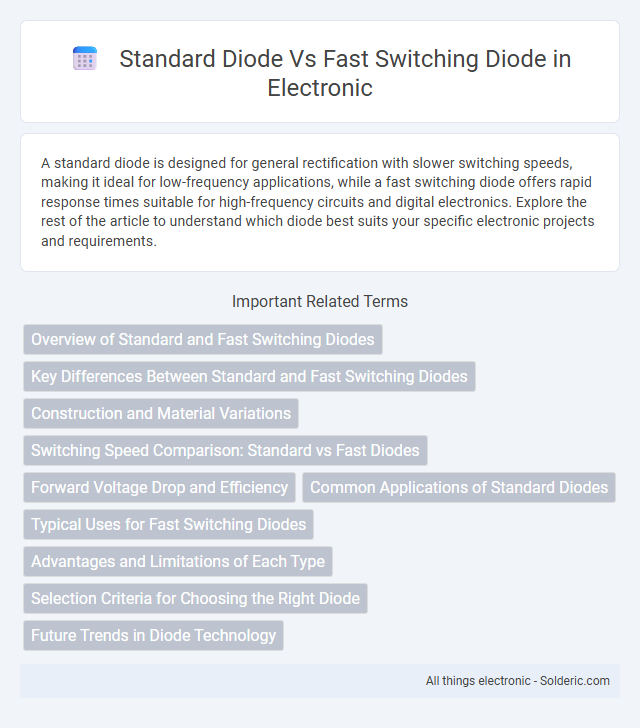A standard diode is designed for general rectification with slower switching speeds, making it ideal for low-frequency applications, while a fast switching diode offers rapid response times suitable for high-frequency circuits and digital electronics. Explore the rest of the article to understand which diode best suits your specific electronic projects and requirements.
Comparison Table
| Feature | Standard Diode | Fast Switching Diode |
|---|---|---|
| Switching Speed | Slow, typically microseconds | Fast, typically nanoseconds to microseconds |
| Recovery Time | High reverse recovery time | Low reverse recovery time |
| Applications | Rectification, power supplies | High-frequency circuits, switching power supplies |
| Junction Capacitance | Higher capacitance | Lower capacitance |
| Forward Voltage Drop | Typically 0.7V (Silicon) | Typically 0.7V (Silicon) |
| Typical Models | 1N4001, 1N4007 | 1N4148, UF4007 |
| Cost | Lower cost | Higher cost |
Overview of Standard and Fast Switching Diodes
Standard diodes primarily serve as rectifiers in power supplies by converting AC to DC with slower recovery times, making them suitable for low-frequency applications. Fast switching diodes feature significantly reduced reverse recovery times, allowing them to efficiently handle high-speed switching in applications such as pulse circuits and high-frequency inverters. Your choice between these diodes depends on the circuit's switching speed and efficiency requirements.
Key Differences Between Standard and Fast Switching Diodes
Standard diodes are designed primarily for low-frequency applications with slower recovery times, while fast switching diodes excel in high-frequency circuits due to their rapid reverse recovery time and minimal charge storage. Your choice depends on the switching speed requirements and operational frequency, as fast switching diodes minimize switching losses and improve efficiency in digital and RF applications. Key differences include the speed of switching, recovery time, and typical use cases, where standard diodes suit power rectification and fast switching diodes are ideal for signal processing and switching regulators.
Construction and Material Variations
Standard diodes are typically constructed with a simple p-n junction using silicon, designed for general rectification with moderate switching speeds and higher reverse recovery times. Fast switching diodes incorporate specialized semiconductor materials or optimized doping profiles, such as epitaxial silicon layers, to reduce charge storage and enable quicker transitions between conducting states. Your choice between these diodes depends on the required switching speed and efficiency in circuit applications.
Switching Speed Comparison: Standard vs Fast Diodes
Standard diodes typically have slower switching speeds, making them suitable for low-frequency applications, whereas fast switching diodes can operate efficiently at higher frequencies due to their reduced reverse recovery time. The fast switching diode's ability to quickly switch between conducting and non-conducting states minimizes power loss and heat generation, improving overall circuit efficiency. Choosing the appropriate diode ensures Your electronic device performs optimally under varying switching speed requirements.
Forward Voltage Drop and Efficiency
Standard diodes typically exhibit a higher forward voltage drop of around 0.7 volts in silicon devices, which results in greater power dissipation and reduced efficiency in high-speed or switching applications. Fast switching diodes have a lower forward voltage drop, often near 0.3 to 0.5 volts, enabling quicker response times and improved energy efficiency by minimizing conduction losses. The reduced forward voltage in fast switching diodes enhances circuit performance, especially in power supply and signal processing systems requiring rapid switching and lower thermal stress.
Common Applications of Standard Diodes
Standard diodes are widely used in power rectification circuits, such as converting AC to DC in power supplies for household electronics and industrial equipment. They are commonly found in voltage regulation, signal demodulation, and protection circuits due to their reliable low-frequency performance. These diodes are preferred in applications where switching speed is less critical, providing efficient current flow control in automotive and consumer electronic devices.
Typical Uses for Fast Switching Diodes
Fast switching diodes are commonly used in high-frequency applications such as switching power supplies, signal demodulation, and high-speed digital circuits where rapid response times are critical. These diodes offer lower reverse recovery times compared to standard diodes, making them ideal for reducing switching losses and electromagnetic interference in your electronic designs. Their ability to efficiently handle fast transient signals ensures improved performance in circuits requiring quick on-off switching cycles.
Advantages and Limitations of Each Type
Standard diodes offer advantages such as lower cost and higher voltage tolerance, making them ideal for general-purpose rectification and protection circuits. Fast switching diodes provide quicker recovery times and reduced switching losses, which enhance performance in high-frequency applications like switching power supplies and digital circuits. Your choice depends on balancing the need for speed with factors like efficiency, power handling, and cost constraints.
Selection Criteria for Choosing the Right Diode
Selecting the right diode depends on your circuit's switching speed requirements and voltage ratings; standard diodes typically support lower switching speeds and are suitable for rectification and general-purpose applications. Fast switching diodes excel in high-frequency circuits due to their rapid recovery times and reduced switching losses, making them ideal for high-speed signal processing and switching power supplies. Consider the forward voltage drop, reverse recovery time, and maximum current ratings tailored to your application to ensure optimal performance and efficiency.
Future Trends in Diode Technology
Future trends in diode technology emphasize enhanced switching speeds and energy efficiency, making fast switching diodes increasingly vital in high-frequency applications. Standard diodes remain integral for general rectification purposes, but innovations are pushing fast switching diodes towards broader adoption in power electronics and communication devices. Your designs will benefit from selecting diodes that align with evolving requirements for reduced switching losses and improved thermal performance.
Standard diode vs Fast switching diode Infographic

 solderic.com
solderic.com